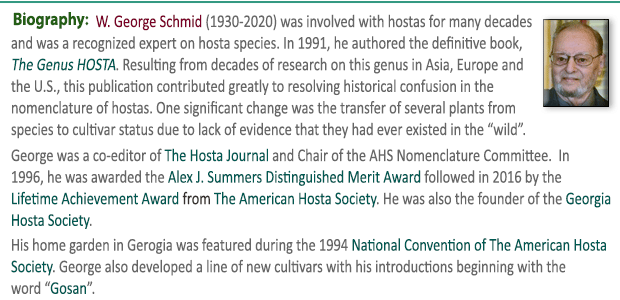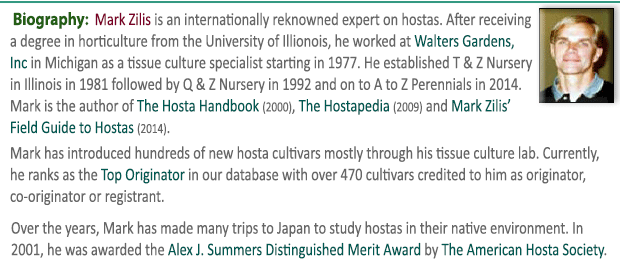|
 This species of
Hosta is small to
medium size (6 to 10 inches high with a spread of 8 to 12 inches) with green foliage. The
foliage is medium to dark green, smooth textured and has thick
substance. Leaves are very shiny underneath, slightly wavy and
have
heart shaped bases. It has dense clusters of pale purple flowers
with purple anthers borne on
20 to 30 inch scapes in August into September. This species of
Hosta is small to
medium size (6 to 10 inches high with a spread of 8 to 12 inches) with green foliage. The
foliage is medium to dark green, smooth textured and has thick
substance. Leaves are very shiny underneath, slightly wavy and
have
heart shaped bases. It has dense clusters of pale purple flowers
with purple anthers borne on
20 to 30 inch scapes in August into September.
The name means "long feet"
supposedly because in its native habitat in
Japan, it sends its roots deep into cracks
of rock outcroppings.
 According to
The Hostapedia by Mark Zilis (2009), "...the most variable species,
with dozens of forms selected for differences in plant size,
leaf underside, leaf shape, leaf color, flower color and other
flowering characteristics." According to
The Hostapedia by Mark Zilis (2009), "...the most variable species,
with dozens of forms selected for differences in plant size,
leaf underside, leaf shape, leaf color, flower color and other
flowering characteristics."
Mark Zilis' Field
Guide to Hostas (2014) states that this species
was found in Japan in "...limestone rocks, on hillsides and cliffs, sometimes
along rivers or streams..."
 Nomenclature changes recommended in the
1991 book The
Genus Hosta by
W. George Schmid and accepted by The American Hosta Society would update names as follows:
H. tortifrons is now H.
'Tortifrons'
and H. tardiflora is H.
'Tardiflora'. Nomenclature changes recommended in the
1991 book The
Genus Hosta by
W. George Schmid and accepted by The American Hosta Society would update names as follows:
H. tortifrons is now H.
'Tortifrons'
and H. tardiflora is H.
'Tardiflora'.
Mikiko Lockwood in an article on The Hosta Library titled,
A Little About Japanese Hosta Terms defines the term iwa as rock, Iwa Gibōshi or
H. longipes.
 
An article about Fall Bloomers by
Herb Benedict and
Jim Wilkins in
The
Hosta Journal (1991 Vol. 22 No. 1) states that, "Here
are some of the fall blooming plants we grow...(listed in the order of bloom
times in Michigan).
| 1) H. kikutii
|
A medium size plant densely flowering
with white blooms. The flowers are equally arranged around the
central axis of the raceme so that the bloom scapes resembles a
bottle brush or pony tail...We are growing two named varieties,
'Hirao-59' and 'Finlandia'. |
| 2) H. 'Fall Bouquet' |
Small, green plant, leaves slightly
undulated, lavender scape and blooms, floriferous. |
| 3) H. longipes |
Small green plant, densely flowering
with a tall stiff bloom scape. The flowers are lavender and the
leaves are green. |
| 4) H. gracillima |
Funnel-shaped, light lavender flowers.
A miniature green plant, with shiny surface. |
| 5) H. 'Iwa' |
Iwa means rock, and this plant was
imported by Marjorie Soules, from Japan. It is a small green plant
with lavender flowers. |
| 6) H. tortifrons |
In the same section (Picnolepis) as
H. longipes and
H. rupifraga. Distinctive small plant, with twisted
green leaves and lavender flowers. |
| 7) H. 'Fused Veins' |
Small, green leaves often with ¼ inch
margin which is a lighter green. The lance shaped leaves are
undulated and the veins come together regularly. The flowers are
mauve and the scape is sometimes branched. |
| 8) H. rupifraga |
Small, medium green, with thick,
leathery, ovate leaves. Densely flowering with purple flowers. 'Urajiro',
'Grand Slam', 'Maruba Iwa' |
| 9) H. tardiflora |
This small hosta is the last to bloom
for us. Its leaves are shiny, dark green and lance shaped. The
flowers are light lavender and borne in abundance on 12 inch scapes. |

 Hajime Sugataof Japan in
The
Hosta Journal (1994 Vol. 25 No. 2) writes, "As the
Japanese name "rock hosta" implies, H. longipes grows between rocks or
cliffs near rivers and waterfalls. The natural habitat of H. longipes is
widely distributed in areas such as Minamishitara County and Kitashitara County
in Aichi Pref., Ena Area in Gifu, Pref., and northern areas of Tenryu City in
Shizuoka Pref. Hajime Sugataof Japan in
The
Hosta Journal (1994 Vol. 25 No. 2) writes, "As the
Japanese name "rock hosta" implies, H. longipes grows between rocks or
cliffs near rivers and waterfalls. The natural habitat of H. longipes is
widely distributed in areas such as Minamishitara County and Kitashitara County
in Aichi Pref., Ena Area in Gifu, Pref., and northern areas of Tenryu City in
Shizuoka Pref.
Most H. longipes around Mt. Horaiji in
Aichi Pref. are of regular form, but occasionally white-backed ones can be
found. Those around Mt. Tanayama are larger and white-backed, and those around
Mt. Iwakoya are smaller and white-Backed.
In Aichi Pref. a few noteworthy forms of H.
longipes are found. A white-margined form on Mt Tanayama named 'Tanayamanishiki',
a streaked form in Makinohara, and a white variegated form in Makinohara, Mikawa
Area, exist. Some H. longipes in Hida Area, Gifu Pref. grow at the
elevation of white birches. A wild hosta is mysteriously attractive because it
has survived through many hardships."

Dr. Ben J.M. Zonneveld in
The
Hosta Journal (1996 Vol. 27 No. 2) states that, "...I
found in the garden of Hideko Gowen,...From her trip with an American part to
Japan a plant called provisionally 'Katsuragawa'...It was selected from a wild
population for its rather strong red petioles and I think it to be a form of
H. longipes. What was remarkable was the fact that a young offset had leaves which
were red all over. We must wait to see if this is maintained when the leaves
grow older, but it shows at least the possibility for a red-leaved hosta."

 An article about growing H. pycnophylla by W. George Schmid in
The
Hosta Journal (2002 Vol. 33 No. 2) states that, "...1)
In the South, H. pycnophylla needs mostly morning sun in spring and shade in
summer...in the North, it needs more sun than shade all day in both spring and
summer. This species is very shy about flowering if it does not get enough
sun...2) As with all relatives of H. longipes, the plant does best if you supply
plenty of water...particularly during summer drought periods. 3) In the North,
plant this species in an open location facing south or southeast to gain
additional growing season...since this is a southern, long-growing-season
species that requires plenty of moisture and warmth (even heat) to flower and
set seed." An article about growing H. pycnophylla by W. George Schmid in
The
Hosta Journal (2002 Vol. 33 No. 2) states that, "...1)
In the South, H. pycnophylla needs mostly morning sun in spring and shade in
summer...in the North, it needs more sun than shade all day in both spring and
summer. This species is very shy about flowering if it does not get enough
sun...2) As with all relatives of H. longipes, the plant does best if you supply
plenty of water...particularly during summer drought periods. 3) In the North,
plant this species in an open location facing south or southeast to gain
additional growing season...since this is a southern, long-growing-season
species that requires plenty of moisture and warmth (even heat) to flower and
set seed."

An article about H. 'Kinu-no-yuki' by Akira Horinaka in
The
Hosta Journal (2006 Vol. 37 No. 1) says, "This is
a very beautiful new cultivar of H. longipes. ..a hybrid of a wild form of
H. longipes named 'Chichibu'...and another
collected form of H. longipes ...called 'Tochiga'...A
relative of 'Kinu-no-yuki', 'Mine-no-yuki' is a hybrid of the wild form of
'Chichibu' and the cultivar 'Kinusouri' (itself a hybrid of a white-veined, wild
'Chichibu' and 'Tochigi')....'Kinu-no-yuki' has a snow-white center with an
irregular and narrow green border...[nearly 2 inch-long] leaf...has the most
pure white center I have ever seen."
Horinaka continues, "Nakafu
means the leaf has a white center surrounded by green; this plant also has a
green accent line within the white center. This is a form of
H. longipes..., one
of the most popular hostas in Japan. It is very similar to a plant called 'Hakuho'
and may be the same plant under a different name or a "sister" plant. 'Okutama
Nakafu' has leaves that average...[just over 5½ inches] long. It is a seedling
from 'Okutama Nishiki', which is green with lovely white-centered streaking and
itself a sport of 'Okutama' a wild form found near Lake Okutama-ko...near
Tokyo."


 |



